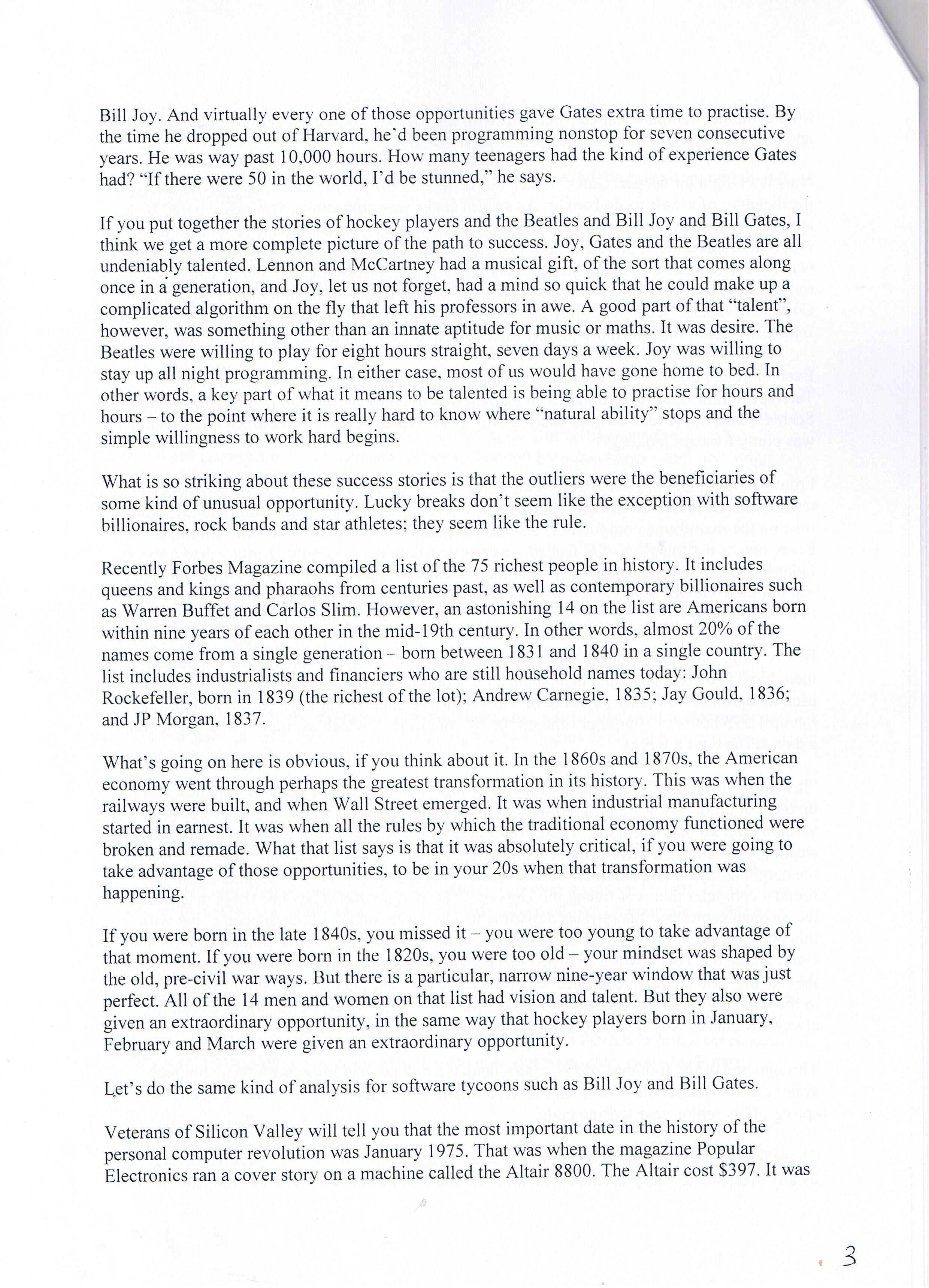CCF20091020�003

Bill Joy. And virtually every one of those opportunities gave Gates extra time to practise. By the time he dropped out of Harvard. he'd been programming nonstop for seven consecutive years. He was way past 10.000 hours. How many teenagers had the kind of experience Gates had? “If there were 50 in the world, Pd be stunned,” he says.
If you put together the stories of hockey players and the Beatles and Bill Joy and Bill Gates, I think we get a morę complete picture of the path to success. Joy, Gates and the Beatles are alł undeniably talented. Lennon and McCartney had a musical gift. of the sort that comes along once in a generation, and Joy, let us not forget, had a mind so ąuick that he could make up a complicated algorithm on the fly that left his professors in awe. A good part of that “talent”, however, was something other than an innate aptitude for musie or maths. It was desire. The Beatles were willing to play for eight hours straight, seven days a week. Joy was willing to stay up all night programming. In either case. most of us would have gone home to bed. In other words, a key part of what it means to be talented is being able to practise for hours and hours - to the point where it is really hard to know where “natural ability” stops and the simple willingness to work hard begins.
What is so striking about these success stories is that the outliers were the beneficiaries of some kind of unusual opportunity. Lucky breaks domt seem like the exception with software billionaires, rock bands and star athletes; they seem like the rule.
Recently Forbes Magazine compiled a list of the 75 richest people in history. It includes queens and kings and pharaohs from centuries past, as well as contemporary billionaires such as Warren Buffet and Carlos Slim. However, an astonishing 14 on the list are Americans born within nine years of each other in the mid-19th century. In other words, almost 20% of the names come from a single generation - born between 1831 and 1840 in a single country. The list includes industrialists and financiers who are still hoiisehold names today: John Rockefeller, born in 1839 (the richest of the lot); Andrew Carnegie. 1835; Jay Gould, 1836; and JP Morgan. 1837.
Whafs going on here is obvious, if you think about it. In the 1860s and 1870s, the American economy went through perhaps the greatest transformation in its history. This was when the railways were built, and when Wall Street emerged. It was when industrial manufacturing started in earnest. It was when all the rules by which the traditional economy functioned were broken and remade. What that list says is that it was absolutely critical, if you were going to take advantage of those opportunities, to be in your 20s when that transformation was happening.
If you were born in the late 1840s, you missed it - you were too young to take advantage of that moment. If you were born in the 1820s, you were too old - your mindset was shaped by the old, pre-civil war ways. But there is a particular, narrow nine-year window that was just perfect. All of the 14 men and women on that list had vision and talent. But they also were given an extraordinary opportunity, in the same way that hockey players born in January, February and March were given an extraordinary opportunity.
Lef s do the same kind of analysis for software tycoons such as Bill Joy and Bill Gates.
Veterans of Silicon Valley will tell you that the most important datę in the history of the personal Computer revolution was January 1975. That was w'hen the magazine Popular Electronics ran a cover story on a machinę called the Altair 8800. The Altair cost $397. It was
Wyszukiwarka
Podobne podstrony:
CCF20091020�003 Bill Joy. And virtually every one of those opportunities gave Gates extra time to pr
CCF20091020�003 Bill Joy. And virtually every one of those opportunities gave Gates extra time to pr
ARCHMELOG and NOARCHIVELOG Modę One of the important decisions you nced to make as a DBA is to deter
Monday. 16 Seplember and tissue formation. One of thc most widely used biomaterials in bonę tissue e
art 09 01 Story and photos by Martin Donnon TECH TQRQUEMild and Wild CA18s One of the morę common ca
ms 032 AN OUTSTANDING PERSONALITY IF YOU TRAIN THE RIGHT WAYAPOIŁON EVERY ONE OF YOU CAN BECOME A RE
milo 01 09 Fiutrac* 5 f left
51 Annex 2.4 Page4 of 6 2000; and (III) to increase the prevalence of contraceptive use from 4.4% to
03 2 ^Jpril Showers 3ring JKay Flowers Connect the dots to find something you may need during one of
więcej podobnych podstron